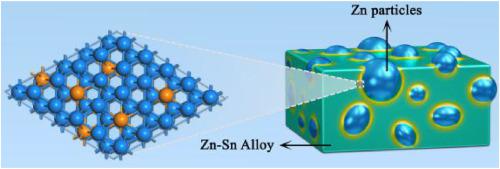Journal of Power Sources ( IF 8.1 ) Pub Date : 2022-02-17 , DOI: 10.1016/j.jpowsour.2022.231173 Yumeng Peng 1 , Changang Lai 1 , Ming Zhang 1 , Xianbin Liu 1 , Yanhong Yin 1 , Yesheng Li 1 , Ziping Wu 1

|
Zinc (Zn) based metal-air battery has been considered as one of promising candidates for the next-generation batteries due to its high theoretical specific capacity and abundant reserve. However, Zn electrode is susceptible to dendrite growth and corrosion depravation in the long cycling process, causing capacity decline and short lifespan. Herein, a novel zinc-stannum (Zn–Sn) alloy electrode has been facilely prepared through powder sintering technology to restrain the dendrite growing and promote the corrosion resistance. Compared with pure Zn foil electrode, the optimized Zn–Sn10 alloy electrode exhibited a lower voltage hysteresis of 119 mV and a better topography with non-dendrite after cycling 400 h at 0.5 mA cm−2. Meanwhile, the Zn corrosion resistance in alkaline electrolyte has been significantly improved. Theoretical calculations also account for these superiorities by the uniform charge distribution in the superficial ZnSn layer. As a result, the assembled Zn-air battery based on Zn–Sn alloy anode electrode showed satisfactory power density, rate properties and cycling life. This research provides a facile and cost-efficient strategy to stabilize Zn anode and holds great promise in developing high-performance rechargeable Zn-based battery energy systems.
中文翻译:

可抑制枝晶生长和改善耐腐蚀性能的锌-锡合金负极用于锌空气电池
锌(Zn)基金属空气电池因其高理论比容量和丰富的储量而被认为是下一代电池的有希望的候选者之一。然而,锌电极在长循环过程中容易发生枝晶生长和腐蚀破坏,导致容量下降和寿命短。在此,通过粉末烧结技术轻松制备了一种新型锌锡(Zn-Sn)合金电极,以抑制枝晶生长并提高耐腐蚀性。与纯锌箔电极相比,优化后的 Zn-Sn10 合金电极在 0.5 mA cm -2循环 400 h 后表现出 119 mV 的较低电压滞后和更好的无枝晶形貌。. 同时,碱性电解液中的抗锌腐蚀能力也得到了显着提高。理论计算还通过表面 ZnSn 层中的均匀电荷分布来解释这些优势。结果,基于Zn-Sn合金负极的组装锌空气电池表现出令人满意的功率密度、倍率性能和循环寿命。该研究为稳定锌负极提供了一种简便且具有成本效益的策略,并在开发高性能可充电锌基电池能源系统方面具有很大的前景。

































 京公网安备 11010802027423号
京公网安备 11010802027423号